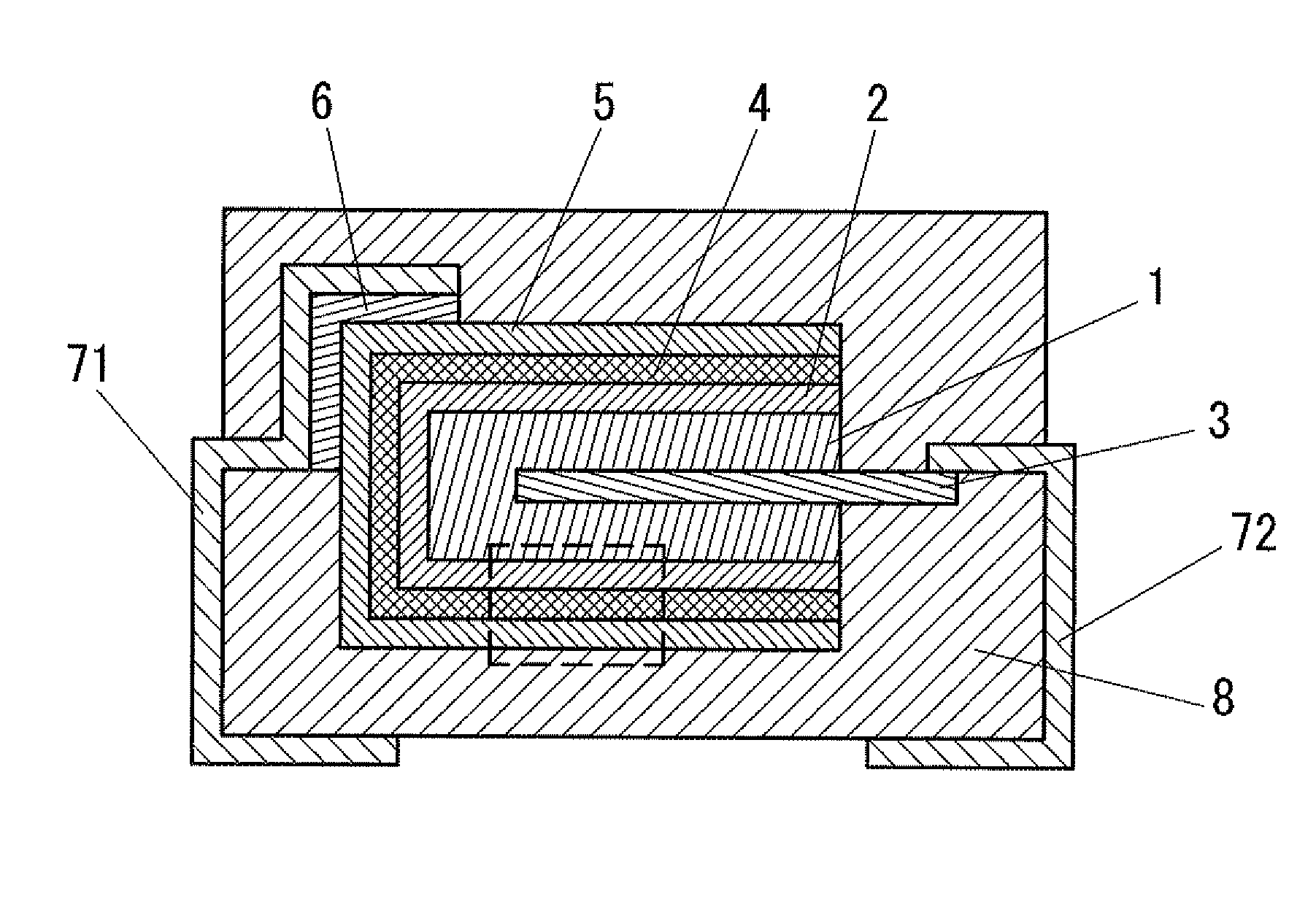Solid electrolytic capacitor and its manufacturing method
a technology of solid electrolytic capacitors and manufacturing methods, which is applied in the manufacture of electrolytic capacitors, liquid electrolytic capacitors, electrolytic capacitors, etc., can solve the problems of difficult formation of thin portions of conductive polymer layers, and difficult to form fine conductive polymer layers, etc., to achieve less likely to cause failures and high reliability
- Summary
- Abstract
- Description
- Claims
- Application Information
AI Technical Summary
Benefits of technology
Problems solved by technology
Method used
Image
Examples
example 1
[0048]A rectangular parallelepiped press body of 3.5 mm in height, 3.0 mm in width, and 1.5 mm in thickness formed of about 30,000 (μFV / g:CV / g) of tantalum powder in which a tantalum wire of 0.4 mm in diameter is embedded as the anode lead 3 was sintered at about 1,500° C. to produce a tantalum sintered body. A voltage of 30 V was applied to this sintered body in a phosphoric acid aqueous solution to carry out anodic oxidation and thereby to form a dielectric layer 2.
[0049]Next, the tantalum sintered body coated by the dielectric layer 2 was submerged in an aqueous solution containing ammonium peroxydisulfate, which is an oxidizing agent, and 1,3,6-naphthalene trisulfonic acid. Next, after dried at a room temperature, it was submerged in 3,4-ethylene dioxythiophene and then kept at a room temperature to polymerize 3,4-ethylene dioxythiophene. A series of these polymerization processes was repeated three times to form a first solid electrolyte layer 9 composed of conductive poly-3,4-...
example 2
[0053]A mixture aqueous solution containing poly-3,4-ethylene dioxythiophene and polystyrene sulfonate in an amount of 3 wt. % (conductive polymer solution A) was used for the formation of the first solid electrolyte layer 9.
[0054]A tantalum sintered body on which a dielectric layer 2 was formed in advance was submerged in the conductive polymer solution A, and then dried at 125° C. for 20 minutes to form a conductive polymer layer. These processes were repeated three times to form a first solid electrolyte layer 9. A commercially-available conductive polymer solution whose D90 is about 30 to 50 nm was used as the conductive polymer solution A. The processes other than these processes for formation of the first solid electrolyte layer 9 were the same as those of Example 1. Further, at this point, the coating rate of the first solid electrolyte layer was 87%.
PUM
| Property | Measurement | Unit |
|---|---|---|
| thickness | aaaaa | aaaaa |
| thickness | aaaaa | aaaaa |
| particle diameter | aaaaa | aaaaa |
Abstract
Description
Claims
Application Information
 Login to View More
Login to View More - R&D
- Intellectual Property
- Life Sciences
- Materials
- Tech Scout
- Unparalleled Data Quality
- Higher Quality Content
- 60% Fewer Hallucinations
Browse by: Latest US Patents, China's latest patents, Technical Efficacy Thesaurus, Application Domain, Technology Topic, Popular Technical Reports.
© 2025 PatSnap. All rights reserved.Legal|Privacy policy|Modern Slavery Act Transparency Statement|Sitemap|About US| Contact US: help@patsnap.com


